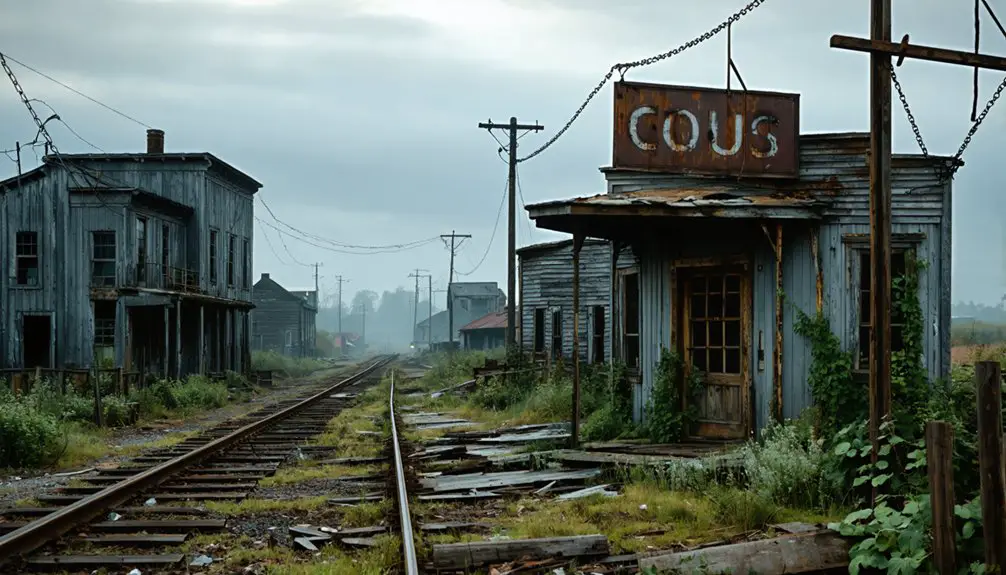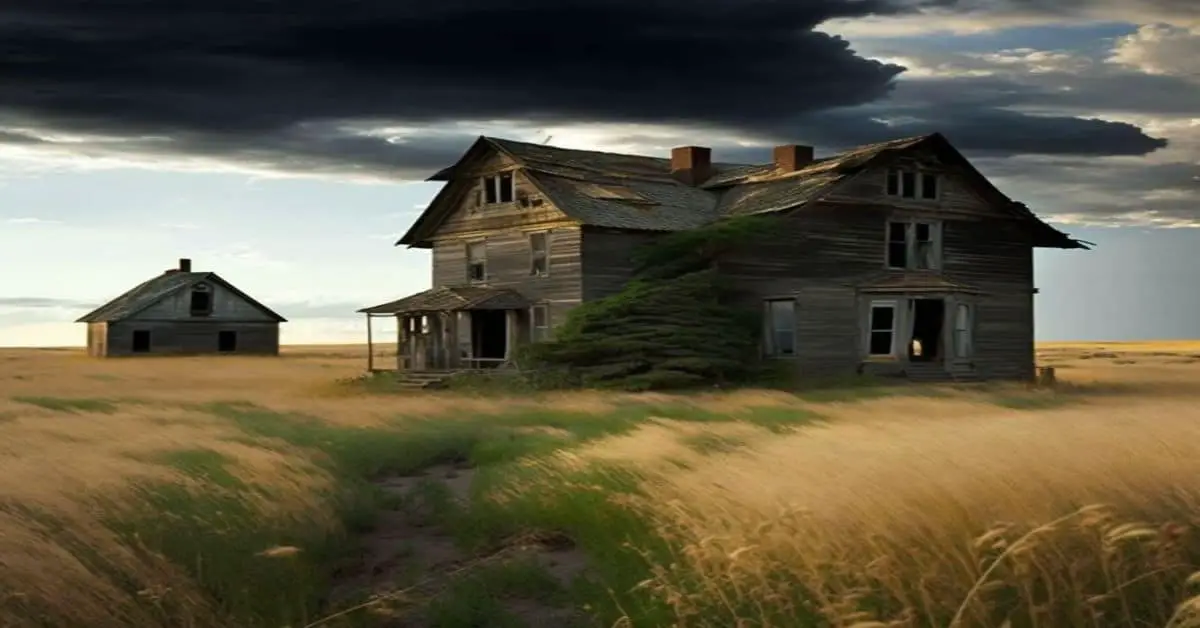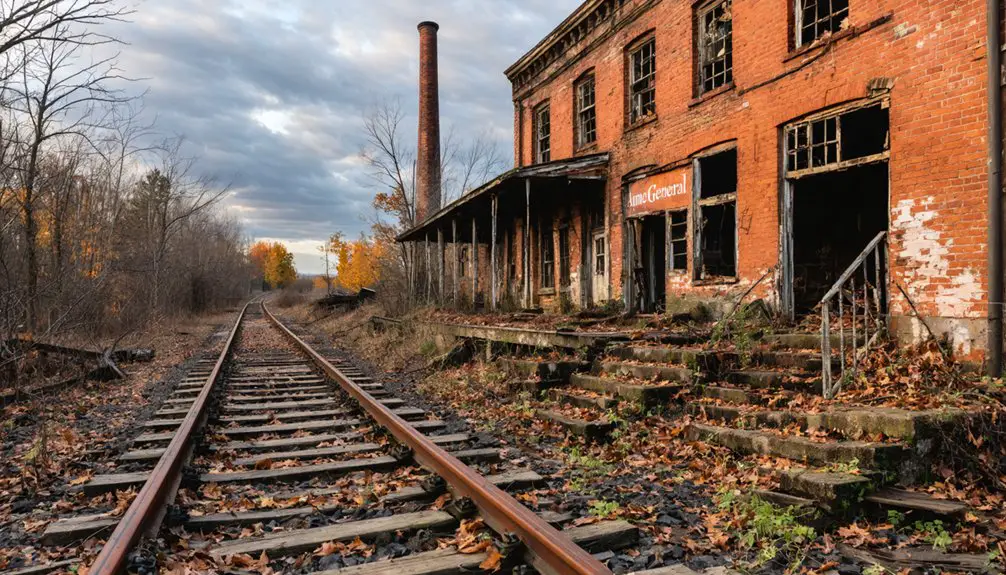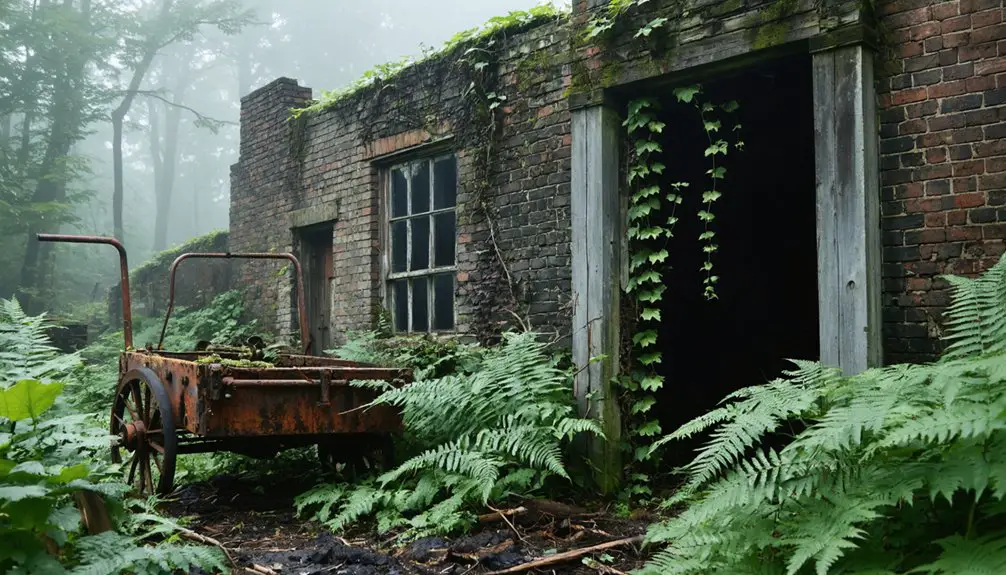You’ll find Buckeye’s ghost town remnants near Carmichaels, Pennsylvania, where a once-bustling coal mining community thrived in the late 1800s. The town’s strategic location along the Monongahela River made it an industrial powerhouse until environmental disasters struck. An underground coal fire and hazardous waste contamination forced residents to abandon their homes, leaving behind haunting structures including townhouses and industrial buildings. The site’s silent ruins tell a compelling story of America’s industrial heritage.
Key Takeaways
- Buckeye became a ghost town after environmental hazards from coal fires and toxic waste contamination forced residents to abandon their homes.
- The town, established by Buckeye Coal Company near Carmichaels, was once a thriving industrial hub along the Monongahela River.
- Max Environmental’s landfill operations and underground mine fires created severe health risks similar to Centralia’s environmental disaster.
- Several historic structures remain standing, including townhouses and industrial buildings with distinctive A-frame supports and milled lumber.
- The abandoned town now features nature reclaiming the area, with trees growing through ruins and wildlife inhabiting former residential spaces.
The Rise and Fall of a Mining Community
When the Buckeye Coal Company established one of Greene County’s pioneering mines near Carmichaels in the late 1800s, few could have predicted its profound impact on western Pennsylvania’s industrial landscape.
You’ll find that Buckeye’s strategic location along the Monongahela River transformed the region into a bustling hub of activity. The company’s innovative mining techniques, including steam-powered locomotives and mechanized extraction methods, drew workers from across Europe seeking opportunities. The mine utilized the traditional room-and-pillar method to maximize coal extraction while maintaining structural stability.
As Pittsburgh’s steel industry demanded more coal, Buckeye’s 800-acre operation thrived on the rich Pittsburgh coal seam, producing high-quality coking coal essential for steel production. The community’s resilience showed through labor disputes and technological shifts, as miners adapted to evolving extraction methods. Daily operations required treating 300,000 gallons of water to protect the Monongahela River from acidic mine pollution.
Driven by Pittsburgh’s growing steel mills, Buckeye’s rich coal seam fueled industrial progress while its miners weathered challenges with determination.
Rail connections from Crucible to Nemacolin expanded Buckeye’s reach, cementing its role in Pennsylvania’s industrial growth.
Life in Historic Buckeye
Although Buckeye never grew into a large settlement, life in this railroad town revolved around a tight-knit community of railway workers and farming families.
You’d find residents gathering at the local church, which served as both a place of worship and a social hub for community gatherings. Children attended a one-room schoolhouse, while their parents worked the rails or tended to agricultural practices in the surrounding fields. Much like Centralia’s vibrant community life, the town fostered strong bonds among its 1,200 residents.
From 1898 to 1902, you could visit the town’s post office, one of the few formal institutions serving this modest population.
Daily life centered around the railroad’s rhythm, with locals supporting each other through seasonal work, shared labor, and cooperative ventures. The town’s John Foust general store was a vital business hub that operated until 1932, serving the community’s daily needs. The presence of businesses like Ceres Solutions reflected the town’s deep connection to farming and transportation industries.
Environmental Impact and Abandonment
The devastating combination of hazardous waste contamination and an underground coal fire sealed Buckeye’s fate as a ghost town. Max Environmental’s negligent operation of a hazardous waste landfill for over 40 years, coupled with the uncontrollable underground mine fire that began in 1962, created severe environmental hazards that forced residents to abandon their homes. Similar to Centralia, Pennsylvania, the town became uninhabitable due to the ongoing underground fire.
The community’s health deteriorated as toxic gases from the mine fire and industrial waste caused respiratory problems, headaches, and chronic illness. Eastern European immigrants contributed to the area’s coal mining heritage, as evidenced by the local cemetery’s grave markers.
Infrastructure crumbled as the burning coal seam created dangerous ground fissures and surface instability.
Remaining Structures and Ghost Town Status
Despite decades of abandonment, several significant structures still stand as silent witnesses to Buckeye’s past. You’ll find the largest building with its distinctive A-frame supports and milled lumber, though its brick walls are slowly crumbling from fallen trees.
Industrial remnants include garage bays and tool-related structures, hinting at the site’s maintenance history. A 2004 wall calendar remnant indicates when operations finally ceased at the water treatment facility. Like Centralia’s buildings that became unsafe due to underground coal fires, many structures have been compromised by environmental factors.
The abandoned architecture tells a story of interconnected lives through rows of townhouses, some now requiring brick supports after neighboring demolitions compromised their structural integrity.
Nature’s reclamation is evident as trees grow through roofless ruins, and wildlife makes homes in the structural decay.
While local authorities have removed many buildings for safety, what remains creates a haunting tableau of former community life, with graffiti-covered walls and scattered artifacts marking time’s passage.
Legacy in Pennsylvania’s Industrial Heritage
Beyond the weathered walls and crumbling structures, Buckeye’s lasting influence on Pennsylvania’s industrial heritage runs deep through multiple sectors.
You’ll find Buckeye heritage woven into the fabric of the state’s industrial evolution, from pioneering pipelines to coal mining innovations. The company’s strategic transition to refined products transportation after World War II demonstrated its adaptability in meeting changing market demands. The indoor plumbing installations in every home marked a revolutionary advancement in coal town living standards.
- Buckeye Pipe Line Company’s 1886 creation under Standard Oil set the foundation for Pennsylvania’s modern petroleum transport infrastructure, with over 6,200 miles of pipeline now serving the region.
- Nemacolin’s model town planning revolutionized mining community standards with modern amenities, showing how industrial progress could enhance workers’ lives.
- Buckeye Steel Castings’ railroad equipment manufacturing helped transform transportation safety while supporting diverse immigrant communities, leaving an enduring mark on the region’s industrial corridor.
Frequently Asked Questions
Are There Any Paranormal Activities Reported in Buckeye’s Abandoned Buildings?
You’ll find numerous haunted sightings and ghost stories, including EVP recordings of voices, unexplained music box sounds, shadowy figures, and cold spots throughout the deteriorating buildings where miners’ families once lived.
Can Visitors Legally Explore and Photograph the Remains of Buckeye?
You’ll need explicit permission from property owners before exploring or photographing, as legal restrictions apply. Check with county offices to identify landowners and follow photography guidelines to avoid trespassing violations.
What Happened to the Cemetery and Burial Grounds in Buckeye?
Like a steadfast guardian, Workman Cemetery endures as the town’s primary historic marker. You’ll find it’s preserved near US 62, though there aren’t strict burial site regulations or cemetery restoration efforts currently active.
Are There Any Seasonal Events or Guided Tours of Buckeye?
You won’t find organized seasonal festivals or guided explorations here. The site’s limited remains – just three homes and an agricultural co-op – mean you’ll need to explore independently on your own schedule.
Did Any Famous People or Historical Figures Come From Buckeye?
You won’t find any famous residents from this location. While Samuel Swaim, Samuel T Jones, and Loren B Minn have historical significance as town founders, they weren’t nationally recognized historical figures.
References
- https://pabucketlist.com/the-rise-and-fall-of-centralia-pas-toxic-ghost-town/
- https://www.youtube.com/watch?v=Qj5LjacccJ0
- https://www.youtube.com/watch?v=NcDbPf4pkCA
- https://www.jeffreydonenfeld.com/blog/2009/12/exploring-the-ghost-town-of-centralia-pennslvania/
- https://en.wikipedia.org/wiki/List_of_ghost_towns_in_Pennsylvania
- https://nemacolin.net/mine/
- https://www.pa.gov/agencies/dep/programs-and-services/mining/bureau-of-mining-programs/pa-mining-history.html
- https://www.fundinguniverse.com/company-histories/buckeye-partners-l-p-history/
- https://www.iup.edu/library/departments/archives/coal/coal-culture-timeline.html
- https://www.bramwellwv.com/buckeyeminingtools.html



